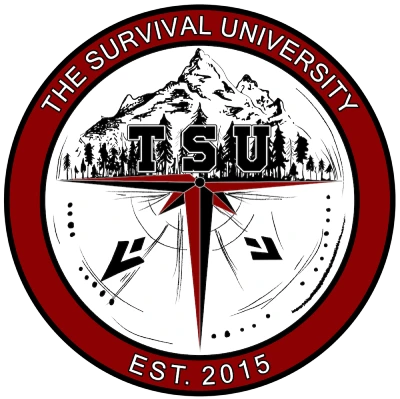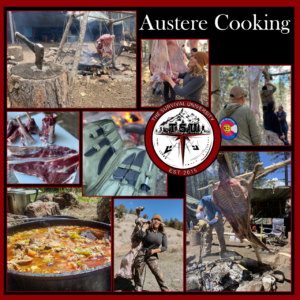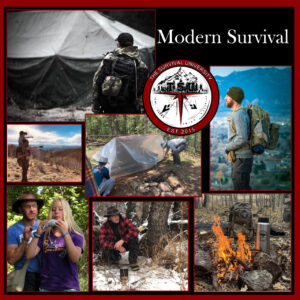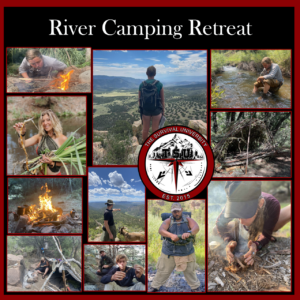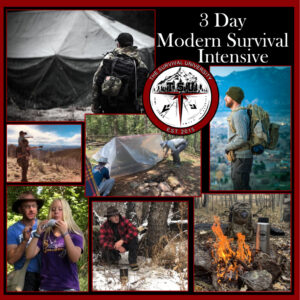Cart
Introduction to Big Game Hunting
$595.00
Ready to put meat in the freezer and experience the hunt from start to finish? This four-day course gives first-time hunters the skills and confidence to step into the field prepared. From navigating regulations and planning your hunt to scouting, tracking, safe weapon handling, and processing game, you’ll cover it all. Along the way, you’ll sharpen your wilderness skills, learn to move like the animals you pursue, and finish by butchering and cooking your own harvest.
This isn’t just theory, it’s hands-on hunting knowledge that takes you full circle, from planning your first tag to the respect and reward of the harvest.
Description
Intro to Big Game Hunting
Ready to step into the world of big game hunting? This immersive course is designed for first-time hunters who want more than just theory. It’s a hands-on experience that takes you from planning and scouting all the way through field processing and cooking your harvest.
You’ll learn the laws and ethics of hunting, how to scout and track animals, and the skills needed to safely and successfully harvest wild game. Along the way, we’ll mix in practical wilderness skills so you gain confidence in both the hunt and the backcountry.
By the end of the course, you won’t just understand the hunt, you’ll know how to prepare, pursue, process, and put food on the table with respect for the land and the animal.
Preparing for the Hunt
This course builds a strong foundation of knowledge and skills for first-time hunters. We blend modern techniques with primitive skills to create confidence in the entire hunting process, from understanding laws and ethics to field processing and cooking your harvest.
You’ll learn how to navigate regulations, plan your hunt, and identify what gear and fitness levels are needed. Instruction will cover scouting and glassing techniques, animal tracking and sign, and how to interpret terrain and habitat features.
We’ll dive into the hunter’s mindset, game behavior, and the strategies that help close the distance on big game. From calling and stalking to scent control and thermals. Students will also gain hands-on experience with safe weapon handling, shooting scenarios, and hunting techniques.
Finally, the course immerses you in the reality of a successful harvest: blood trailing, anatomy, field dressing, butchering, long-term storage, and cooking. To round it out, we’ll touch on self-sufficiency in the wilderness, practicing survival skills like fire, shelter, water, kit mentality, and emergency planning.
Course Topics
-
Figuring out your reason “why”
-
Navigating Game and Wildlife website and brochures
-
Planning your hunt
-
Method of legal take
-
Weapon safety
-
Knowing your weapon
-
E-scouting and physical scouting
-
Setting a camp
-
Basic orienting
-
Tracking and reading animal sign
-
Learning animal behavior
-
Calling
-
Hunting strategies and techniques
-
Field processing wild game
-
Packing out
-
Butchering
-
Long-term storage
-
Cooking
-
Basic survival skills
-
Communications and creating an emergency action plan
Course Outcome and Demonstrated Skills
-
Understand hunting laws, ethics, and responsibilities
-
Navigate wildlife brochures and resources with confidence
-
Plan a hunt, meet requirements, and apply for a license
-
Know essential gear and physical fitness needs
-
Scout effectively using both maps and on-the-ground techniques
-
Track and interpret wild game sign
-
Learn about species and their habitat
-
Apply different hunting strategies
-
Handle weapons safely and become a confident marksman
-
Stay calm and accurate in both ideal and non-ideal shooting positions
-
Track downed game and field dress safely
-
Pack out and preserve meat in the wilderness
-
Butcher and prepare game for storage or freezing
-
Cook a variety of wild game safely
-
Set up camp, build fire, and filter water
-
Gain basic primitive skills and tool knowledge
-
Create and execute an emergency action plan
Hunter Skill Set
-
Specific animal behavior and habitat
-
Understanding animal signs and tracks
-
Moving in animal habitat (wind, noise, scent control)
-
Closing the distance: stalking, calling, and setup
-
Hunting strategies and etiquette
Method of Harvest (Weapons)
-
Weapon safety: firearm, archery, and muzzleloader
-
Proper handling and care of rifles, shotguns, and pistols
-
Choosing firearms and ammunition
-
Understanding scopes, sights, and other essentials
-
Archery basics: styles and gear
-
Muzzleloader basics and operation
-
Shooting scenarios: ideal and non-ideal positions
Successful Harvest of Game
-
Blood trailing and reading sign
-
Safety and site setup for field processing
-
Large game anatomy (deer, elk, etc.)
-
Field dressing and processing techniques
-
Caring for meat in the field and packing out
-
Butchering and processing for storage
-
Cooking and preparing wild game
Wilderness Living and Survival
-
Choosing a campsite and shelter building
-
Water sourcing, filtering, and storage
-
Fire making with and without tools
-
Kit mentality and readiness
-
Safety and situational awareness (lightning, floods, etc.)
-
First aid basics
-
Emergency action planning and communication
-
Basic navigation essentials
Course Name: Intro to Big Game Hunting
Location: Mountain Camp, Colorado – 9,500 ft elevation, pine and aspen forest, private land
Schedule: Check-in at 9:00 AM, class runs 10:00 AM – 5:00 PM daily
Duration: 4 Days
Approach: Hands-on training, beginner-focused, modern and primitive hunting skills, wilderness integration
Instructor Type: TSU Resident Instructor
Driving Directions: [Click here for directions]
Address: 71 Monarch Dr, Cripple Creek, CO 80813
(Important: Our camp is remote and GPS is often unreliable. Please read these directions carefully and have them saved or printed before you leave. Cell service is limited once you head into the mountains.)
Accommodations
Students may camp on-site or stay in nearby towns. Cripple Creek is 15 minutes away, Woodland Park is 30 minutes. Students arrange their own lodging if not camping. At camp, a central fire ring and a few designated sites are available, with dispersed camping as the primary option. Cars can be parked within 100 feet of camp.
Sleeping Arrangements: Students are responsible for their own overnight shelter (tent, camper, hammock, or tarp setup).
Facilities: Porta potty restroom and potable water provided.
Food and Water
Potable water is available at camp. Students bring their own food. Quick meals like freeze-dried pouches or MREs are recommended, though you may bring any food suitable for campfire cooking or personal stoves. Local groceries and restaurants are nearby.
Gear List
Core Hunting Tools
-
Fixed-blade knife (full tang, 4–5” blade, plain edge)
-
Ferrocerium rod and striker
-
Folding hand saw
-
Overnight camping gear (tent, sleeping bag, pad, etc.)
-
Small backpack or daypack
Clothing & Protection
-
Outdoor boots and wool socks
-
Rain gear or poncho
-
Outdoor clothing (layered, season-appropriate)
-
Sunglasses or hat for sun
-
Insect repellent
Cooking & Water
-
Metal pot and eating utensils
-
Single-walled metal canteen or water bottle
-
Meals and snacks
Lighting & Miscellaneous
-
Headlamp with spare batteries
-
Personal first aid kit
-
Notebook and pencil (optional)
Optional Comfort Items
-
Camp chair or stool
-
Pillow or cushion
-
Extra snacks or comfort food
-
Camera or phone for photos
